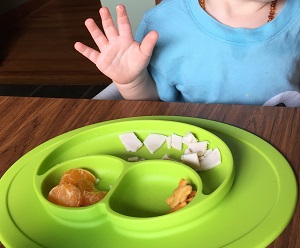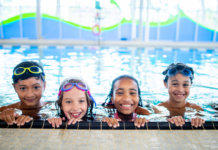The sun shines past bedtime, the flowers and trees overflow the garden bed, and the pool water glistens in the light. The school year must be ending.
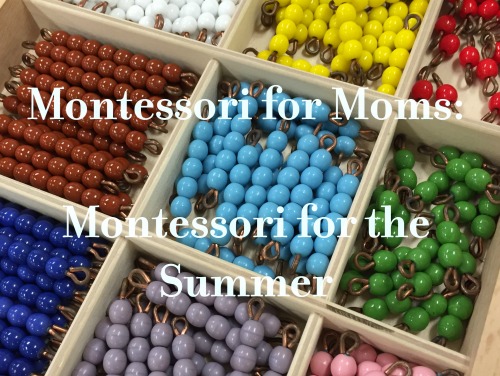 Knoxville Montessori School certainly stayed busy all year. According to KMS’s Senior Primary Teacher, Valerie Kuéntz, students learned how to observe others, teach their peers, and direct themselves. They’ve learned how to respect themselves, others and their environments. So, what happens when the students are home during summer?
Knoxville Montessori School certainly stayed busy all year. According to KMS’s Senior Primary Teacher, Valerie Kuéntz, students learned how to observe others, teach their peers, and direct themselves. They’ve learned how to respect themselves, others and their environments. So, what happens when the students are home during summer?
These Montessori at home tips are brought to you by Knoxville Montessori School.
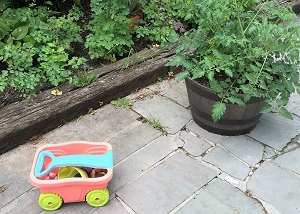
In our recent KMS newsletter, Ms. Kuéntz assures parents that Montessori environments can be made at home. She offers these general guidelines:
- Allow your children to observe you as you complete chores/activities and let them help.
- Offer time for your child to problem solve by himself/herself.
- Demonstrate new skills you want to see your child accomplish but give him/her space to practice.
- Create an environment that includes your child’s needs.
- Give your child age-appropriate responsibilities and activities.
- Respect your child and expect respect in return.
- Keep it simple and have fun!
Whether your child is in a Montessori program, at home for the summer, or not in a program at all, these guidelines can help you set up your house in a way that makes Montessori fun and helpful for you and your child.
I’m trying Montessori-minded changes in our house with my 16-month-old son. It doesn’t require extra money, but does involve more time, patience and mindfulness. I found these changes to be simple, but not always easy. I want to share with you some techniques I try in each room of our home. If you can budget for child-size supplies, check out: forsmallhands.com and melissaanddoug.com
Kitchen:
My son is usually with me when I’m throwing together breakfasts or preparing complicated dinners. I talk clearly about my actions, such as chopping onions, to include him in the activity.
In the kitchen, there are many practical life activities. Lately, he’s learned about lids. I lay different lids and containers on the floor, and he stays very busy testing each lid. He helps clean – I spray vinegar water on low surfaces, and he wipes them with a small rag. Soon, he will use the spray bottle, himself. He also helps stir the actual food on the stove or in the mixing bowl.
For his environment, there is a floor-level cupboard beside the dishwasher that contains his own utensils, cups and bowls. Every time we go into the kitchen, he automatically opens his cupboard and pulls out an item to explore.
A step-stool or chair come in handy for older toddlers who are ready for advanced activities like cooking and washing dishes. For toddler appropriate food preparation, check out Living Montessori Now.
Dining Room:
During dinner, we remove loud distractions, such as the TV. While eating, we take time to talk about the food. Some days he tastes, touches and smells new, exciting foods.
One lesson is keeping his food on the table and entails much repetition of “the plate stays on the table.” He watches me set his plate and helps wipe down his area after eating. Another lesson is utensils – scooping his food with a small spoon to bring to his mouth.
Soon, he will be ready to set up his own dinner setting with a placemat, cloth napkin and cutlery. He may also be ready to have a small table by himself that can be taken outside and also used for arts and crafts.
Indoors, we often sweep the dining area with a small hand broom. If you are interested, try this mini sweep and mop set.
Living Room/Toy Room:
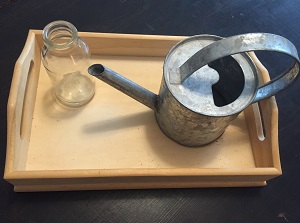 Before dinner and bedtime, we are in the family room, a.k.a. the toy room. When I am actively playing with him on the floor, I try to give him space to understand his toys, which are mostly age-appropriate.
Before dinner and bedtime, we are in the family room, a.k.a. the toy room. When I am actively playing with him on the floor, I try to give him space to understand his toys, which are mostly age-appropriate.
For example, he plays with a wooden push toy, but often cries for help when it’s “stuck.” I used to roll the toy backwards for him; now, I wait for him to figure out how to roll it away from the wall or chair.
We practice cleanliness by picking up all the toys before we move on to other rooms. His toys are stored in a simple cube organizer that sits low to the ground, so he can pull out the cloth boxes by himself to remove and return his own toys and books.
For older children, there are lessons you can set up in a “TV dinner” style tray at home. Find several DIY activities for your toddler and older children at Living Montessori Now.
Bedroom:
In the bedroom, we try to create a calm and peaceful atmosphere, without being excitable, upset or stressed, ourselves. If we are not calm and relaxed, how can we expect him to be?
Every morning we make the bed and he may tug at the blankets to help. His designated dresser drawer is low to the ground for his own clothes. He opens and closes his drawer at any time, especially when he helps put away laundry. We try to be mindful with this because if we don’t remind him to “keep the drawer closed,” his clothes end up in every corner of the house.
His bookshelf is also low. When we read together, he is encouraged to grab a books from the bookshelf by himself. If he grabs several books, I will hold up two and let him pick one.
Outside:
There are unlimited opportunities to teach my son how to respect his natural environment. On the weekends, we may find ourselves outdoors all morning and afternoon. We hang out around our house, walk through downtown or play at our neighborhood park.
If he sits near me while I work in the garden, I try to explain digging mulch, planting the tomato plants, or watering the herbs. He learns about worms, little lizards, plants, water and dirt.
He has a miniature shovel for his own activities, such as putting mulch in his mini wheel barrel. The messier, the better, as long as we sweep up after each session.
At his age, there are so many benefits from all simple activities, such as a playing with cups in a kiddie pool, chalk drawing or a strolling up and down our street. For more outdoor ideas, check out Living Montessori Now.
Within each room, I try to take time to think, “How can I show him to do (activity) by himself?,” “what can he learn by doing (activity) by himself?,” “how can I make (activity) possible and enjoyable for him?”
More resources:
 Livingmontessorinow.com – a great resource for activity ideas for all ages and environments.
Livingmontessorinow.com – a great resource for activity ideas for all ages and environments.
Montessorium.com – another great resource for activity ideas, apps and dialogue about Montessori.
Dailymontessori.com – helpful lists for understanding age-appropriate toys and activities.
Marenschmidt.com – a blog that posts useful weekly newsletters.
At Home with Montessori, by Patricia Oriti – a short, light introduction to Montessori in the home.
Also check out our previous post on Montessori for Moms at Home.
About Annie
Annie Brown is a mother of her 1-year-old son. She grew up in Blount County, and attended Maryville College for a degree in Writing and Communications. Now, she resides in South Knoxville near Downtown and Ijams Nature Center. Recently, she began working as the administrative assistant at Knoxville Montessori School, between Sequoyah Hills and Bearden. She enjoys writing, cooking, being outdoors and raising her son.











